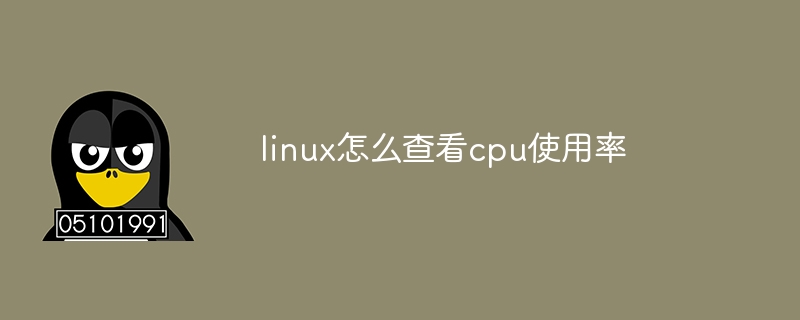
How to check CPU usage in Linux: 1. top command; 2. htop command; 3. vmstat command; 4. mpstat command; 5. GNOME System Monitor; 6. KDE System Guard; 7. nmon; 8. Write scripts for monitoring.

In Linux systems, checking the CPU usage is a common task. It can help system administrators and developers understand the load of the system so that they can Performance tuning or troubleshooting. The following will introduce in detail the various methods of viewing CPU usage in Linux, including using command line tools, graphical interface tools, and writing scripts for monitoring.
1. Command line tools
1. top command
The top command is a commonly used performance analysis tool under Linux. It can display the resource usage of each process in the system in real time, similar to the Windows Task Manager. You can view it by entering the top command directly in the terminal.
In the output of top, you can see the CPU usage, including the percentage of CPU occupied by user space (%us), the percentage of CPU occupied by system space (%sy), the percentage of idle CPU (%id), etc. These indicators can help you determine the load on the system.
2. htop command
htop is an enhanced version of the top command, providing a colorful interface and more interactive functions. Through htop, you can view CPU usage more intuitively, including the load of each CPU core. If htop is not installed on the system, you can install it through a package manager (such as apt, yum, etc.).
3. vmstat command
The vmstat command is used to report information about processes, memory, paging, block IO, traps, and CPU activity. Through the vmstat 1 command (the following number indicates the refresh interval in seconds), you can view the CPU usage in real time, including user mode CPU usage (us), system mode CPU usage (sy) and idle CPU usage ( id) etc.
4. mpstat command
mpstat is part of the sysstat package and is used to display the status of each available CPU. Through the mpstat -P ALL command, you can check the usage of all CPU cores, including user mode, system mode, idle mode, etc.
2. Graphical interface tools
In addition to command line tools, Linux also provides some graphical interface tools to view CPU usage. These tools are usually more intuitive and easier to use. .
1. GNOME System Monitor
For Linux distributions using the GNOME desktop, GNOME System Monitor is a built-in system monitoring tool. It can display the usage of CPU, memory, network and other resources, and supports real-time refresh. You can launch GNOME System Monitor through the application menu or terminal.
2. KDE System Guard
For Linux distributions using the KDE desktop, KDE System Guard is a similar system monitoring tool. It provides rich functions and visual interface to facilitate users to view and manage system resources.
3. nmon
nmon is a cross-platform performance monitoring tool, suitable for Linux, AIX, Solaris and other systems. It provides a colorful text interface that can display the usage of multiple resources such as CPU, memory, network, disk, etc. in real time. With nmon, you can easily monitor system performance bottlenecks and anomalies.
3. Write scripts for monitoring
In addition to using ready-made tools, you can also write scripts to monitor CPU usage. This usually involves reading the /proc/stat file or calling a system command (such as top, vmstat, etc.) and parsing its output. Through scripts, you can implement customized monitoring logic and alarm mechanisms to meet specific needs.
For example, you can write a bash script that regularly reads the /proc/stat file and calculates the CPU usage, and then outputs the results to a log file or sends an alarm email. Such scripts can be easily integrated into existing monitoring systems to achieve automated performance monitoring and troubleshooting.
4. Notes
When checking the CPU usage, you need to pay attention to the following points:
1. Distinguish between user mode and system mode: User-mode CPU usage indicates the CPU time occupied by the application when executing tasks; system-mode CPU usage indicates the CPU time occupied by the kernel when executing tasks (such as system calls, interrupt processing, etc.). The sum of the two can reflect the overall load of the system.
2. Consider multi-core processors: Modern computers are often equipped with multi-core processors, so looking at the usage of each CPU core is crucial to fully understand the system performance.
3. Combine with other indicators: In addition to CPU usage, you also need to pay attention to the usage of other resources such as memory, disk, network, etc., in order to more comprehensively evaluate the performance status of the system.
4. Pay attention to the refresh interval: When viewing the CPU usage in real time, you need to set an appropriate refresh interval (such as 1 second or a few seconds). A refresh interval that is too short may cause the interface to flicker or fail to accurately reflect the actual load of the system; while a refresh interval that is too long may not detect performance problems in time.
In short, Linux provides a variety of methods to view CPU usage, and you can choose the appropriate method according to your needs and habits. By monitoring and analyzing CPU usage, you can better understand the performance status of your system and optimize and adjust accordingly.
The above is the detailed content of How to check cpu usage in linux. For more information, please follow other related articles on the PHP Chinese website!




